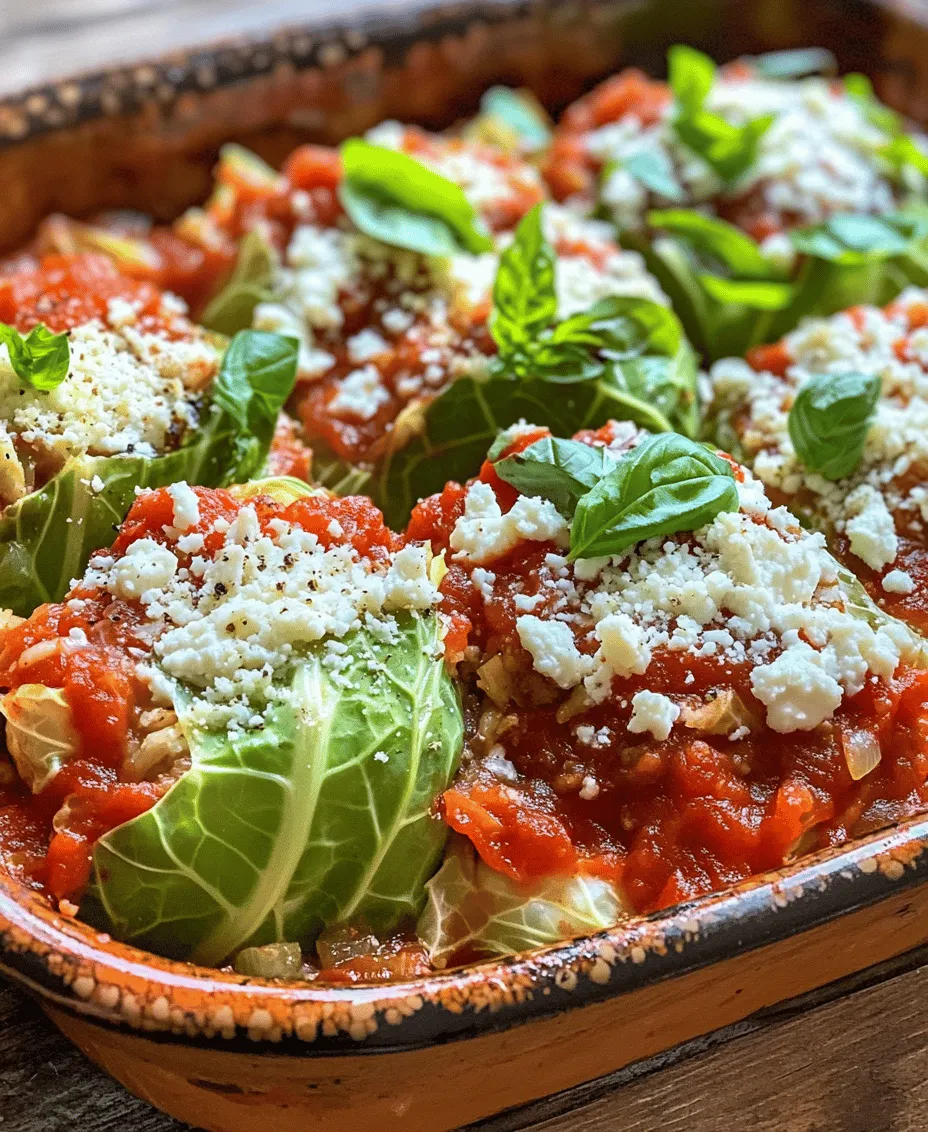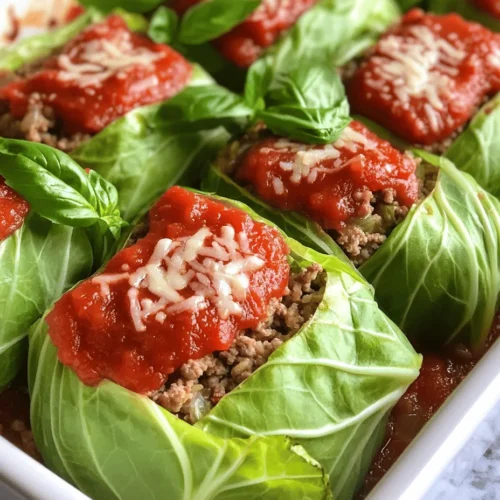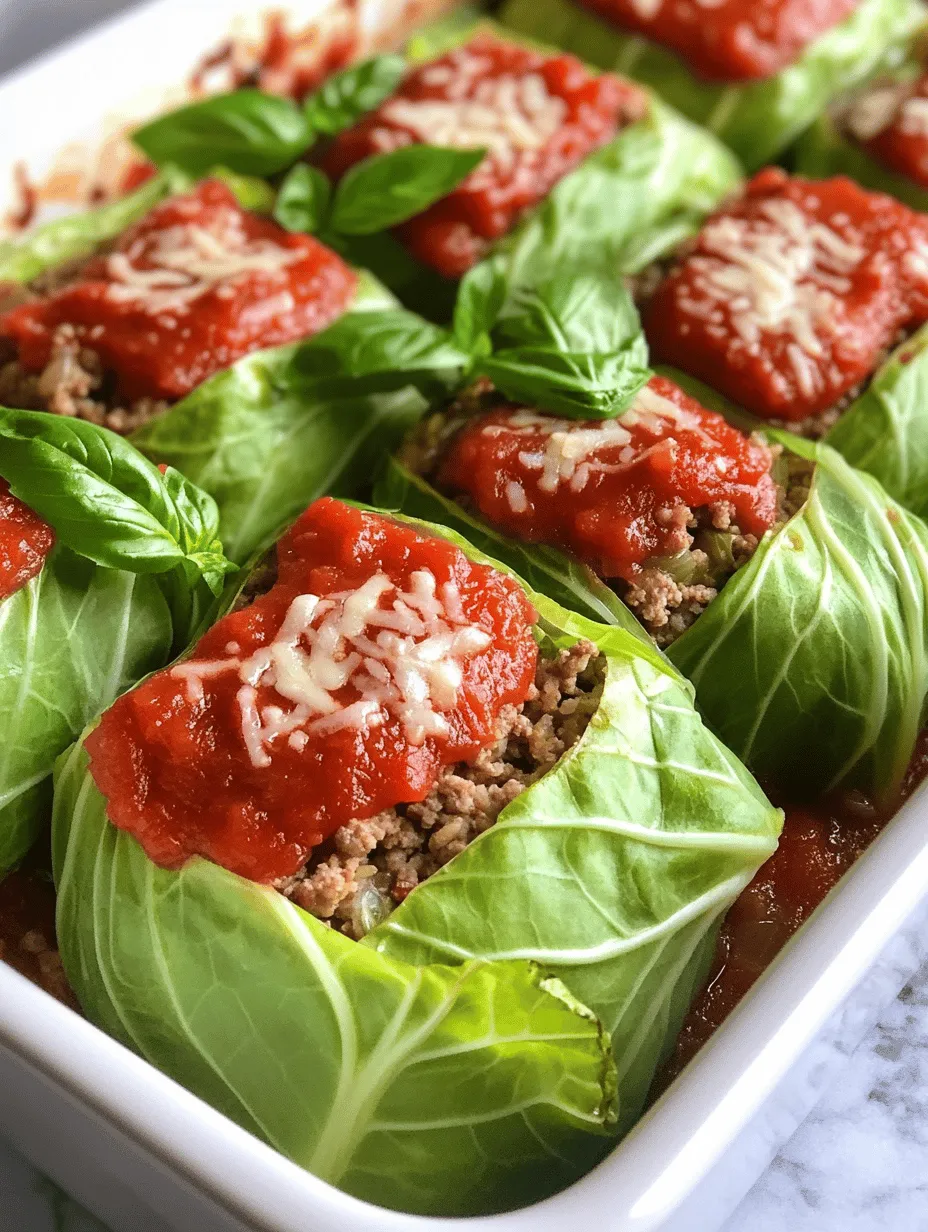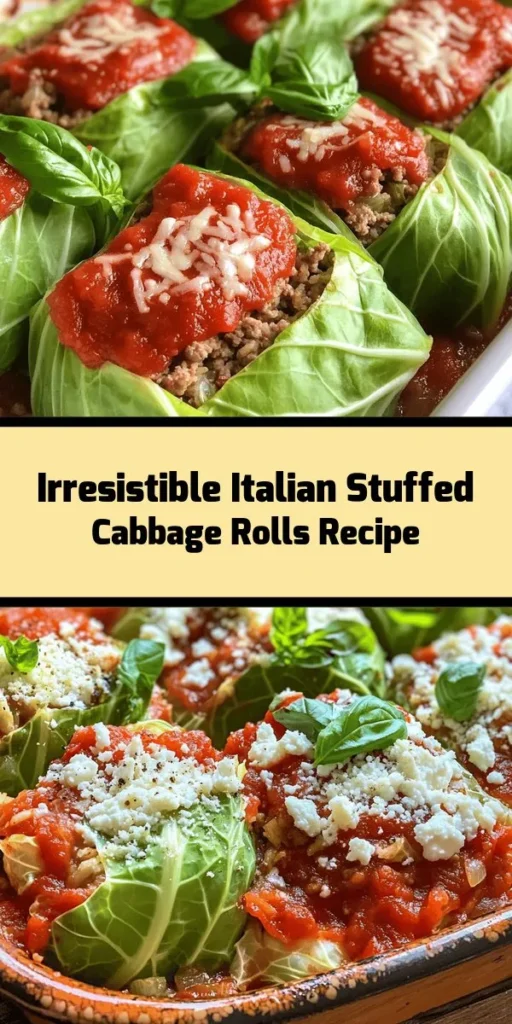Introduction to Italian Stuffed Cabbage Rolls
Italian Stuffed Cabbage Rolls, or “involtini di cavolo,” exemplify the heartwarming essence of Italian cuisine. This dish, with its rich history and comforting flavors, holds a special place in many Italian households. Traditionally, cabbage rolls are a way to use up leftover ingredients, making them a practical choice for families. Today, they are celebrated as a beloved comfort food that brings together loved ones around the dinner table.
The preparation of Italian Stuffed Cabbage Rolls involves a delightful assembly of fresh ingredients. The base is green cabbage, which is blanched to soften the leaves, making them pliable for rolling. The filling typically consists of a mixture of ground meat—often a combination of beef and Italian sausage—along with rice, cheese, and an array of seasonings. Once assembled, these rolls are simmered in a savory tomato sauce, enhancing their flavors and ensuring a moist, tender bite. The combination of textures and tastes makes this dish not only satisfying but also a true representation of Italian culinary tradition.
The Appeal of Italian Cuisine
Italian cuisine is renowned worldwide for its emphasis on fresh ingredients and bold flavors. At its core, Italian cooking celebrates the quality of its components, focusing on seasonal produce, high-quality meats, and aromatic herbs. The preparation techniques often involve simple methods that allow the natural flavors of the ingredients to shine. This approach is especially evident in dishes like Italian Stuffed Cabbage Rolls, where each element contributes to a harmonious blend of taste.
Family meals hold a central place in Italian culture, reflecting the importance of connection and shared experiences. Recipes are often passed down through generations, each family adding its unique twist, thus creating a rich tapestry of culinary traditions. Stuffed cabbage rolls, with their versatility and comfort, fit seamlessly into this narrative. They can be made for special occasions or simple weeknight dinners, embodying the spirit of togetherness that defines Italian dining.
Understanding Cabbage as a Versatile Ingredient
Cabbage is a nutritional powerhouse, offering numerous health benefits while being low in calories. Rich in vitamins C and K, as well as fiber, it supports a healthy diet and contributes to overall well-being. This versatility makes cabbage a favorite in many culinary traditions, including Italian cuisine. Within the cabbage family, there are various types—green, red, savoy, and Napa—each with distinct flavors and textures.
For stuffed dishes, green cabbage is often the preferred choice due to its large, tender leaves, which are ideal for wrapping fillings. The leaves maintain their structure during cooking, preventing them from becoming mushy. This characteristic makes them perfect for holding the flavorful mixture of meats, rice, and seasonings that define Italian Stuffed Cabbage Rolls.
Ingredients Breakdown for Italian Stuffed Cabbage Rolls
Creating the perfect Italian Stuffed Cabbage Rolls involves a thoughtful selection of ingredients, each playing a crucial role in the overall flavor and texture of the dish.
1. Ground Beef vs. Italian Sausage: The choice between ground beef and Italian sausage can significantly impact the flavor profile. Ground beef provides a mild, hearty base, while Italian sausage introduces a robust, seasoned taste with hints of fennel and herbs. Many cooks prefer a blend of both for a balanced flavor that combines tenderness with a savory kick.
2. Rice: Rice acts as a binding agent in the filling, helping to hold all the ingredients together while also adding bulk. Arborio rice or long-grain rice are popular choices, as they absorb flavors well and contribute to a pleasant texture.
3. Cheese Varieties: Incorporating cheese into the filling elevates the dish. Parmesan cheese adds a salty, nutty flavor, while ricotta offers creaminess and moisture. The combination not only enhances the taste but also creates a satisfying mouthfeel that complements the savory meat and rice.
4. Vegetables – Onion and Garlic: Aromatic vegetables like onion and garlic are essential for flavor development. Sautéing them in olive oil before mixing them into the filling releases their natural sweetness and depth, creating a well-rounded taste.
5. Seasonings: Italian seasoning—a blend of herbs like oregano, basil, and thyme—infuses the filling with traditional Italian flavors. Additionally, a dash of red pepper flakes can add a touch of heat, appealing to those who enjoy a little spice in their dishes.
6. Ingredient Substitutions: For those with dietary preferences or restrictions, there are plenty of options. Ground turkey or chicken can be used as leaner meat alternatives, and for a vegetarian version, a mix of lentils and mushrooms can provide a hearty filling. Gluten-free rice or quinoa can substitute for regular rice, making this dish accessible to various dietary needs.
Step-by-Step Instructions for Crafting the Perfect Cabbage Rolls
Preparing the Cabbage
The first step in making Italian Stuffed Cabbage Rolls involves preparing the cabbage leaves. Here’s how to achieve perfectly pliable leaves:
1. Selecting the Cabbage: Choose a firm, fresh head of green cabbage. Look for vibrant green leaves that are tightly packed.
2. Blanching the Cabbage: Fill a large pot with water and bring it to a boil. Carefully remove the core from the cabbage using a sharp knife. Once the water is boiling, submerge the entire head of cabbage for about 2-3 minutes. This process softens the leaves, making them easier to roll without tearing.
3. Cooling and Separating Leaves: After blanching, use tongs to transfer the cabbage to a bowl of ice water. This stops the cooking process and preserves the vibrant color. Once cooled, gently peel away the leaves, setting them aside on a clean kitchen towel to drain.
4. Trimming the Leaves: If the leaves are particularly thick at the stem, use a sharp knife to trim the spine slightly, making them more pliable. This ensures that they roll easily without splitting.
Importance of Leaf Pliability
The pliability of the cabbage leaves is crucial for successful rolling. If the leaves are too stiff, they may crack or break, leading to a less-than-ideal presentation and a potential mess during cooking. Softening the leaves through blanching not only makes them easier to handle but also helps them retain moisture during the cooking process, resulting in tender, flavorful cabbage rolls.
With the cabbage prepared and the filling ingredients ready to go, you’re well on your way to crafting a delicious dish that embodies the warmth and richness of Italian cuisine. In the next section, we will delve deeper into the assembly and cooking process, ensuring that your Italian Stuffed Cabbage Rolls turn out perfectly every time.

Making the Filling: Tips for Achieving the Right Flavor and Consistency
Creating the perfect filling for your Italian stuffed cabbage rolls is crucial for achieving that authentic taste that makes this dish a beloved classic. Start with high-quality ground meat; a blend of beef and pork is traditional, as it provides a rich flavor and moisture. When mixing the meat with rice, choosing a short-grain variety such as Arborio can enhance the texture and absorb flavors better.
Next, don’t overlook the importance of seasoning. Utilize fresh herbs like parsley and basil to add brightness to your filling. Minced garlic and finely chopped onion are essential aromatics that will deepen the flavor profile. A touch of grated Parmesan cheese or a spoonful of tomato paste can add umami and richness to the mix. Be sure to season with salt and pepper, but remember that the sauce will also contribute to the overall seasoning of the dish.
Importance of Sautéing Aromatics
Sautéing your aromatics—onions, garlic, and any other vegetables—before adding them to the filling can dramatically enhance the taste of your cabbage rolls. Cooking these ingredients until they are translucent and fragrant releases essential oils and flavors, infusing the filling with a depth that raw ingredients cannot provide. This step not only elevates the overall taste but also ensures that the filling has a uniform consistency, preventing any unwanted crunchiness from raw onions or garlic.
Assembling the Rolls: Techniques for Rolling and Securing the Filling
Once your filling is prepared, it’s time to assemble the cabbage rolls. Start by carefully peeling off the cabbage leaves; you may need to blanch them in boiling water briefly to make them pliable. Lay one leaf on a clean surface, and place a generous spoonful of filling at the base of the leaf, leaving some space on the sides to fold over later.
To roll, start by folding the sides of the leaf over the filling, then roll it up from the base to the tip, ensuring the filling is secure inside. The technique is similar to rolling a burrito. If you’re worried about the rolls coming undone during cooking, you can secure them with toothpicks or kitchen twine.
Visual Cues for Proper Rolling
When rolling cabbage leaves, pay attention to the visual cues. The cabbage leaf should be flexible but not overly wilted; it should hold its shape without tearing. The filling should be snug but not overflowing, as this can cause the rolls to split during cooking. As you practice, you’ll develop a feel for the right amount of filling and the proper tightness for rolling.
Preparing the Sauce: Combining Flavors for a Rich Topping
The sauce for your stuffed cabbage rolls is just as important as the filling. Begin with a base of crushed tomatoes or tomato sauce, which will provide acidity and moisture. To elevate the flavor, consider sautéing some diced onions and garlic, then adding them to the sauce. A splash of red wine can add complexity, while a pinch of sugar can help balance the acidity of the tomatoes.
Herbs like oregano, thyme, and bay leaves are traditional additions that will deepen the sauce’s flavor, and don’t forget to season with salt and pepper. Allow the sauce to simmer for at least 20 minutes; this will meld the flavors together beautifully.
Importance of Layering Flavors in the Cooking Process
Layering flavors is a fundamental technique in Italian cooking, and it is particularly important in preparing your stuffed cabbage rolls. When you layer the sauce over the rolls in your baking dish, make sure to pour some sauce at the bottom first. This prevents the rolls from sticking to the pan and ensures they cook evenly.
As the rolls bake, they will soak up the flavors of the sauce, enriching the filling. The final result is a dish where each component complements the others, creating a harmonious culinary experience.
Baking for Perfection: Achieving the Ideal Texture and Flavor
When it’s time to bake, preheat your oven to 350°F (175°C). Cover the baking dish with aluminum foil to retain moisture during the cooking process. This step is essential for ensuring that the cabbage rolls remain tender and juicy, as the steam created will help cook the rice and meat thoroughly.
Bake the rolls for about 45 minutes to an hour. Halfway through, remove the foil and allow the tops to brown slightly—a delectable caramelization will form, enhancing both the appearance and flavor of your dish. The rolls are done when the cabbage is tender, and the internal temperature of the filling reaches 160°F (71°C).
Serving Suggestions and Pairings for Italian Stuffed Cabbage Rolls
When serving your Italian stuffed cabbage rolls, consider pairing them with crusty Italian bread. A good bread can complement the meal perfectly, allowing you to soak up the delicious sauce. A simple mixed greens salad dressed with olive oil and balsamic vinegar can provide a fresh contrast to the hearty rolls.
For a more substantial side, try roasted vegetables or garlic mashed potatoes. These sides will balance the richness of the stuffed cabbage and create a well-rounded meal.
For beverage pairings, a medium-bodied red wine, such as Chianti or Sangiovese, will enhance the flavors of the dish beautifully. Their acidity will cut through the richness of the meat and sauce, making every bite enjoyable.
You might also consider serving the rolls family-style, where everyone can help themselves, or plating them individually with a sprinkle of fresh parsley or basil for a touch of color and freshness.
Nutritional Profile of Italian Stuffed Cabbage Rolls
Understanding the nutritional content of your meal can help you make informed choices. Italian stuffed cabbage rolls are generally a good source of protein, especially if you use lean meats. The cabbage itself is low in calories and high in fiber, which promotes digestive health.
Incorporating vegetables into the filling, such as bell peppers or mushrooms, can enhance the nutritional value, adding vitamins and minerals. Additionally, using whole grain rice or substituting quinoa for a gluten-free option can increase the fiber content of the dish.
If you’re looking to make the recipe healthier, you can opt for lean meats like turkey or chicken, or even plant-based proteins such as lentils or mushrooms. These modifications will maintain the heartiness of the dish while reducing the saturated fat content.
Cultural Variations of Cabbage Rolls Around the World
Cabbage rolls have a rich history and are celebrated in various cultures worldwide. Eastern European countries, such as Poland and Hungary, have their own versions, often filled with rice and meat and served with a side of sour cream. These variations might differ in spices or the type of meat used, showcasing regional flavors.
In the Middle East, cabbage rolls are often filled with a mixture of rice, minced meat, and a blend of spices unique to the region, sometimes topped with a tangy tomato sauce or yogurt. Asian versions, such as Korean “sangchu-guk,” may incorporate different ingredients, including kimchi and other vegetables, presenting a completely unique flavor profile.
The global appeal of cabbage rolls lies in their adaptability; they can be tailored to suit different tastes and dietary preferences, making them a versatile dish loved by many.
Conclusion: The Enduring Legacy of Italian Stuffed Cabbage Rolls
Italian stuffed cabbage rolls are more than just a meal; they embody comfort, tradition, and the joy of cooking for loved ones. This dish has a special place in many family kitchens, passed down through generations as a beloved staple.
Encouraging you to try this recipe is not just about savoring a delicious dish but also about creating memories that last a lifetime. The process of preparing, cooking, and sharing these rolls can bring families and friends together, fostering connections through the love of homemade meals.
As you embark on your culinary journey with Italian stuffed cabbage rolls, remember that the art of cooking is about more than just following a recipe—it’s about embracing the flavors, traditions, and stories that make every meal meaningful. Enjoy the process and the delightful experience of sharing your creation with those you care about, and let this dish become a cherished part of your personal culinary heritage.



